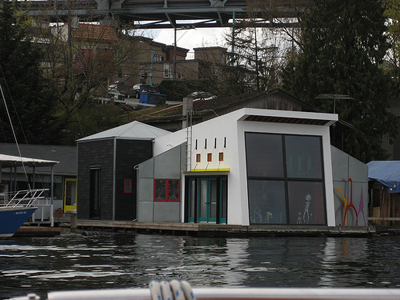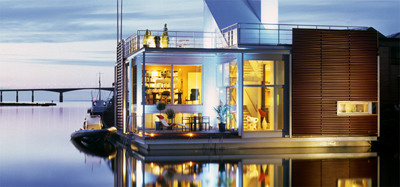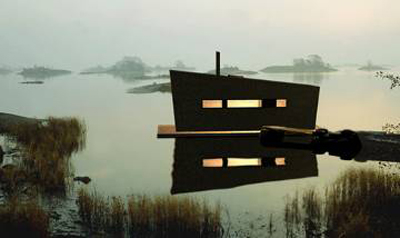Living, working and blogging in Seattle, it was only a matter of time before we felt obligated to post on floating houses. In doing our homework we spoke with Dan Wittenberg, president of International Floatation Systems Inc. (IMF), who was gracious enough to give us a bit of his time and expertise. In addition to designing and building floating homes all over the world, Dan previously lived in a floating home for 11 years. Here’s a bit of our conversation:
Are there any common misunderstanding that architects have about floating homes?
Many architects think that we build hulls or vessels, but that’s not true, we build floating platforms. These platforms are solid construction made with a concrete shell and a Styrofoam core. The platform has positive flotation and will not sink under any conditions, whereas a hollow vessel can fill with water and sink. The technology is comparable to a cork in that it won’t sink regardless of how many holes you poke in it.
What are the material options with a floating platform?
The floating platforms are only built with concrete and Styrofoam; this is a common construction method that insures they won’t sink. It is possible to build a shell which offers interior space (like a basement) but since it’s possible for a shell to sink, insurance companies look at the situation differently. It is still an engineered product but has a different risk factor.
Is there maintenance necessary for the platform floats?
There is no maintenance necessary below the water line.
Are the hulls made in Canada and brought down by tug boat?
For a floating house in Seattle, yes – we build them in Vancouver B.C. and bring them down by tugboat.
Are the houses always installed on the platforms after shipment?
Actually 90% of our residential projects are built on the platform prior to shipping. Some of these homes are finished all the way down to the furniture being installed. We have literally handed owners a key to a move-in ready home at the dock upon arrival.
Does IMF typically build the house as well as the platform?
We certainly can, we are also a general contractor for the homes on top of the floating platforms.
What are the maximum sizes?
For a two story structure the minimum width and length is typically 20’. For a three story structure the minimum width and length is typically 25’.
There is no maximum size limit as the platforms can be constructed piece by piece or poured on site.
The largest floating platform we have constructed is in Holland and is 90,000 square feet. We have also completed a platform on Lake Powell in Arizona which is a one piece construction of 27,000 square feet.
So the platforms can be shipped in 2 or more pieces and connected on site?
Yes, it’s common. We are currently doing a project in Richland which involves 8 separate pieces to be connected together.
What is a common depth?
Five feet is the common depth of the platform, although they only require 3’ of water to float. The platforms are designed to float with 3’ of draft in the water and 2’ of freeboard above the waterline. The 2’ above the water line is the reserve buoyancy. These platforms are designed for a live load of 100lbs per square foot plus the effect of wind on the platform and house.
How far can you ship the platform?
We typically only ship them by water as far as Seattle. Further than that, other means are more cost-effective. We recently delivered a floating platform in several pieces to New York via truck. We also build many of the floating platforms in place. We have built floating platforms as far away as Holland.
Is the means of transportation ever taken into consideration for the design of the floating platform? For instance a triangle would have less drag in shipping and would save on fuel charges.
The amount of fuel it would save wouldn’t add up to much given the overall costs of a floating platform. We have built a triangle platform but for other reasons.
Is there a rule of thumb for pricing?
The base pricing ranges between $50 – $60 per square foot. This does not include plumbing, rails or what we call the ‘jewelry’. This pricing only relates to the floating platform itself.
What is the market telling you about floating house design?
That maximum square footage is more important than privacy. Years ago floating homes were designed with porches and covered outdoor spaces, now the footprint is always maximized for interior space.
The mortgage and insurance industries have changed for the better regarding floating homes. It used to be that neither group recognized floating homes as real-estate. Mortgage companies now see the surface of water as real-estate and insurance companies will now cover floating homes because of the advances in floating platforms.
What are common mistakes made by architects in designing floating homes?
When the floating platform is complete, it is just as functional as a slab on grade. The slab can be clear sealed and used as the finished floor or the finished floor can be installed directly on top of the slab. Architects commonly design the house to use joists at the ground level which is unnecessary.
Radiant heat can also be installed in the platforms we build. It actually makes a lot of sense because there is 5’ of insulation below, making it a very efficient heat system.
Often architects do not take into consideration that all 4 sides of a houseboat have the potential for great views and light. Most of the time we see typical house designs simply plunked down on the floating platform.
All too often architects don’t take into consideration the reflected light from the water. The light on the ceiling of a floating home is much more dramatic than typical residential design.
How can architects best prepare for designing a floating home?
In most cases it is wise to bring the floating platform designer on board early.
Are there design options you would like to see further explored with floating homes?
I would like to see round platforms explored. This would allow rotation of the platform for better views and maximum sunlight throughout the day. It also has applications for solar panels and rotating the panels to best align with the suns rays during the day.
Are there other challenges involved with floating houses?
Securing moorage is difficult as there are only about 500 spots in a place like Seattle. But typically the home owners have found moorage by the time they select their architect and begin working with us.
For more information about floating platforms visit IMF’s website. A huge thanks goes out to IMF, when we land that houseboat project we know who to call.
The following photos show a range of floating houses in a variety of locations by different architects and engineers.
Scandinavian Archipelago Villa in Villa Helmi by Marina Housing

Floating house in Seattle by Vandeventer + Carlander

[Photo by John Granen]
Floating Boathouse and Sleeping Cottage on an island in Lake Huron by MOS Office
Photos from Materialicio.us, which has a phenomenal spread on the house


Floating house in Seattle, does anyone know the architect of this one?

Floating house in Denmark

Modern Marine Homes in Sweden by Strindberg Arkitekter

SeaSauna, Originally by Ari Leinonon now prefabricated by Modernliving.se in Sweden

Floating house in Australia by Drew Heath

Office by Aero11 Design

B-Type floating home by Floatinghomes in Germany

[Photo by Klaus Frahm]





